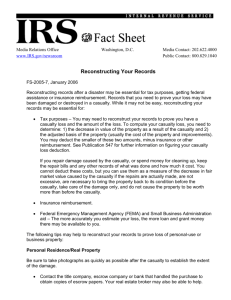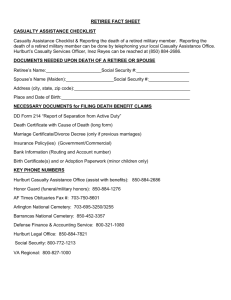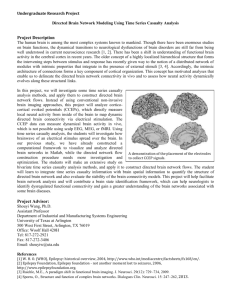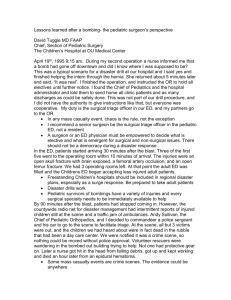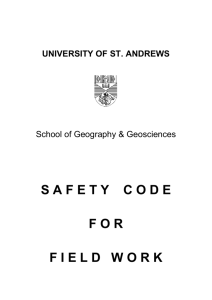Mass Casualty Information Decision Support
advertisement
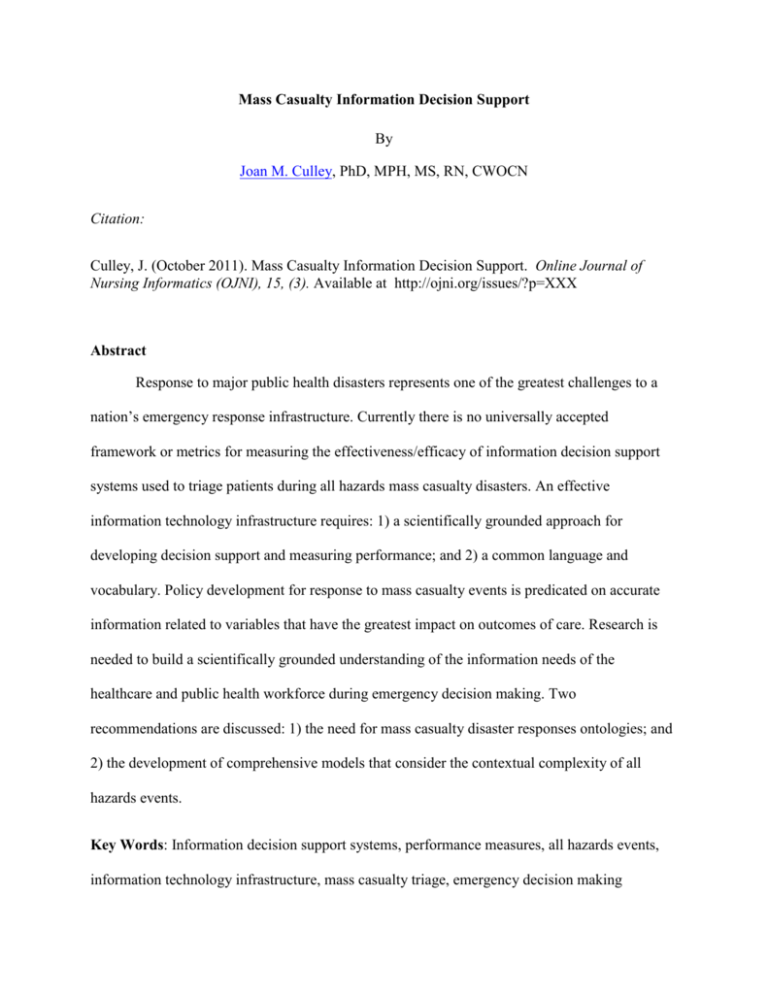
Mass Casualty Information Decision Support By Joan M. Culley, PhD, MPH, MS, RN, CWOCN Citation: Culley, J. (October 2011). Mass Casualty Information Decision Support. Online Journal of Nursing Informatics (OJNI), 15, (3). Available at http://ojni.org/issues/?p=XXX Abstract Response to major public health disasters represents one of the greatest challenges to a nation’s emergency response infrastructure. Currently there is no universally accepted framework or metrics for measuring the effectiveness/efficacy of information decision support systems used to triage patients during all hazards mass casualty disasters. An effective information technology infrastructure requires: 1) a scientifically grounded approach for developing decision support and measuring performance; and 2) a common language and vocabulary. Policy development for response to mass casualty events is predicated on accurate information related to variables that have the greatest impact on outcomes of care. Research is needed to build a scientifically grounded understanding of the information needs of the healthcare and public health workforce during emergency decision making. Two recommendations are discussed: 1) the need for mass casualty disaster responses ontologies; and 2) the development of comprehensive models that consider the contextual complexity of all hazards events. Key Words: Information decision support systems, performance measures, all hazards events, information technology infrastructure, mass casualty triage, emergency decision making 2 Introduction Events such as hurricane disasters, tsunamis, and the 2001 attacks on the World Trade Center and Pentagon clearly illustrate the inadequacy of current mass casualty response systems. The world faces an uncertain future clouded by the persistent threat of terrorist actions, as well as the management of large numbers of seriously injured patients that could be expected during catastrophic events. Such events could produce large numbers of casualties that would overwhelm existing healthcare facilities, jeopardizing the lives of victims and healthcare providers. Effective coordination and management of mass casualty events requires the availability of timely, accurate information about patients, resources, and environmental conditions. The lack of a scientifically grounded understanding of the information and technology needs of the healthcare and public health workforce during mass casualty events, and the paucity of ontologies that permit knowledge sharing, hamper scientific inquiry into mass casualty response research. The use of information decision support systems for the care of mass causalities has been the focus of the majority of mass casualty research without a clear understanding of the data or technology needed to provide real-time decision support for healthcare providers and public health personnel. No consensus currently exists on standardized definitions or the common factors that influence the effective management of mass causalities. Our understanding of mass casualty disaster response relies on a conceptualization of the concepts and relationships that hold among them to create a standardized knowledge base (ontology) for the study of mass casualty response. Capturing details about the collection and analysis of accurate, reliable, timely, and appropriate data during the chaos of a mass casualty event is challenging. It is difficult to predict 3 when and where a mass casualty event will take place which makes conducting prospective or randomized studies to examine the efficacy of decision support data and methods used during mass casualty events difficult. Research is needed to build a scientifically grounded understanding of the information and technology needs of the healthcare and public health workforce during emergency decision making. This paper discusses the importance of a scientifically grounded approach for developing decision support and measuring performance based on a common language (ontology) and the use of comprehensive theoretical models that consider the contextual complexity of all hazards mass casualty events. Theoretical models combined with the use of ontologies provide the framework to study data from multiple sources and perspectives to better understand the variables that have the greatest impact on outcomes of care. Background Mass causality events are almost a daily occurrence. On average a disaster occurs in the world each day. Over the past 20 years more than 188 million people have been affected by disasters worldwide resulting in loss of life and $535 billion in economic damages (http://www.unisdr.org/eng/media-room/facts-sheets/fs-trends--natural-disasters.htm). On January 12, 2010 the largest earthquake ever recorded in the Caribbean hit Haiti killing over 230,000, leaving thousands homeless, many without adequate healthcare, or socioeconomic services. March 11, 2011 one of the largest earthquakes ever recorded (9.0 magnitude) spawned a deadly tsunami that impacted Japan’s east coast, leaving thousands dead, injured, or homeless, and the world fearful of possible radiation leaks from damaged nuclear power plants. Over the past twenty years more than 26,000 deaths occurred in the United States from catastrophic events. August 29, 2005, with winds gusting over 175 mph, Hurricane Katrina hit the Gulf coast 4 of Louisiana, Mississippi, Alabama, and the pan handle of Florida killing 1,056 people (67% were over the age of 61). It took more than 4 days to airlift over 4,000 people from the area to safety. November 5, 2009, Maj. Nidal Malik Hasan fired more than 100 rounds of ammunition at soldiers processing for deployment at Fort Hood in Texas resulting in 13 deaths and 30 people wounded. On January 6, 2005, in Graniteville, South Carolina, two trains collided releasing 60 tons of chlorine gas that resulted in the deaths of 9 people, the treatment of over 250 people and injuries, and long term health and socioeconomic effects to more than 600 residents of the community. These disasters serve as stark reminders that timely and adequate response to major public health disasters represents one of the greatest challenges to a nation’s emergency response infrastructure. Each is an example of the uniqueness of all hazards events. All hazards events refer to catastrophic events that include natural occurrences such as hurricanes and floods, unintended (technological) events such as chemical spills, fires, and deliberate acts such as terrorism. All hazards events may also involve radiological or biological material. Mass casualty events such as these, put huge demands on health and emergency services. Continuity of health services must be maintained while increasing surge capacity (i.e., the ability to handle increased numbers of patients quickly and efficiently). This is especially true in cases where resources are limited and victims are isolated from services. The management of large numbers of causalities expected during mass casualty events creates a disparity between needs and resources. The primary goal of mass casualty triage is to identify and treat patients that have the greatest chance for survival with healthcare intervention. When casualties overwhelm existing resources the ability of healthcare providers to do the greatest good for the greatest number is predicated on the validity and effectiveness of triage data that is used to make life and 5 death decisions about the priority of care for victims. Decision support systems provide the information needed to determine priorities based on the appropriate allocation of limited resources. Statement of the Issue The organizational structure for each mass casualty event is distinctive in terms of its short and temporary lifecycle. For example, the potential for conflicting prioritization criteria for treatment, as well as the disparate and unpredictable nature of the multidisciplinary work force teams, environmental conditions, and patients, makes each event unique (Culley, 2007; Hoey and Schwab, 2004). Mass casualty incidents require that responders have sufficient information on which to base their understanding (frequently referred to as “situational awareness”) of the event as it evolves. Situational awareness refers to the ability to make timely, effective decisions during rapidly evolving events. When situational awareness is lost, administrators are forced to make resource allocation decisions without adequate information, consequently leading to the ineffective utilization of staff, supplies, equipment, and ultimately poor patient outcomes (Culley, 2007). A successful response to an all hazards event depends on clear, accurate, complete, timely, valid, and relevant data that track patients, personnel, resources, and potential hazards (Sundnes and Birnbaum, 2003). Existing information systems are inadequate to support these functions (Ash, Berg, and Coiera, 2004; Birnbaum, 2002) and often provide contradictory information (Jederberg, 2005). Reliable decision support depends upon the use of common terms and abbreviations understood by all members of the workforce to facilitate the concurrent analysis of workforce and environmental factors, treatment priorities, and overall effectiveness (Joint Commission on Accreditation of Healthcare Organizations, 2005). 6 However little is understood about the complexity of mass casualty response, the influence of these factors on disaster response, and the factors that must be considered in designing and evaluating information decision support under these conditions. The science of disaster medical research is observational or often anecdotal and more descriptive than analytical (Benson, Koenig and Schultz, 2006; Birnbaum, 2000; Birnbaum, 2002; Burstein et al., 1996; Chan et al., 2004; Domres et al., 2001; Frykberg, 2002; Gebbi and Merill, 2002; Hoey and Schwab, 2004; Ihlenfeld, 2003; Kilner, 2002; Knop et al,. 1988; Landau, 1982; MacKenzie, Alcorta and Kelen, 1999; Parker, 2006; Rüter, 2006; Schultz, Koenig and Noji, 1996; Sharma, 2005; Sundnes and Birnbaum, 2003). Most of the research related to the use of information decision support systems employed for the care of mass casualties involves the evaluation of existing or emerging technologies without a clear understanding of the information, technology, systems, and decision support needs of healthcare providers and public health officials (Culley and Effken, 2009). Currently there is no universally accepted theoretical framework to guide the design of information-decision support and measuring the effectiveness or efficacy of information decision support systems. (Culley and Effken, 2009; Sundnes and Birnbaum, 2003). Only one of several adult triage systems currently in use in the United States has been evaluated using outcome data from transportation disaster injuries (Kahn, 2009). No other system includes assessments of incidents involving chemical, radiological, or biological material, and none have been evaluated for use with the evolving information and communication technologies (Armstrong, Frykberg and Burnis, 2008; Fernandes et al., 2005), an important gap in disaster research (Jenkins et al., 2008). Research is needed to build a scientifically grounded understanding of the information needs of the healthcare and public health workforce during emergency decision making. This 7 provides the structure to develop standardized data collection methodologies and accurate quality standards, metrics, and assessments (Ash, Berg, and Coiera, 2004) to evaluate the efficacy of information decision support. Mandates for Improving Information Processing The Institute of Medicine and numerous studies discuss the need for clinical information systems and technology in the area of emergency preparedness and response. In 2001, the Institute of Medicine (IOM) published a report that called for fundamental change to close the quality gap in the current health system. The report offered a set of performance expectations for the 21st century health care system that included key steps to strengthen clinical information systems which have been relatively untouched by the revolution in information technology. Disaster care is cited as a special area of concern. In 2008, the IOM published another report that established research priorities in emergency preparedness and response for public health systems. Recommendation 2 addressed the development of communications that improve the timely exchange of vital and accurate information with diverse audiences. Recommendation 3 stressed the importance of the systems and infrastructure needed for a sustainable disaster response and recommendation 4 emphasized the importance of research that will generate criteria for evaluating public health emergency preparedness, response, and recovery and metrics for measuring their efficiency and effectiveness. This was again reinforced in the 2010 IOM report that recommended a blueprint for the future of nursing that included better data collection and an improved information infrastructure for effective workforce planning and policy making. The Centers for Disease Control and Prevention (CDC) also published a report (2006) that encourages the exploration of: the relationship between health systems’ performance and health outcomes; approaches for evidence-based public health decision support systems and 8 prioritization systems; measurement tools and data evaluation strategies regarding public health outcomes; and technologies to enable effective communication of information and data to the appropriate persons at the appropriate time and in the appropriate format. The US is lagging in the adoption of national policies that promote the use of information technology (Davis, Schoen, and Stremikis, 2010). This is particularly evident in disaster care where currently the majority of systems for disaster response and field health care rely on paper triage tags and pen and paper to record aggregate information on patients, ambulance availability and hospital status. Radio and face-to-face interactions have been the primary communication methods to deliver information about patient and resource status (Culley, 2007). Both military and civilian researchers are currently developing sophisticated information system technology prototypes to coordinate and enhance the care of mass casualties. Computer miniaturization, personal digital assistants (PDAs), and wireless technologies have allowed the development of mobile data acquisition and monitoring devices that are being tested specifically for use at disaster sites. For example, the WIISARD First Responder (WFR) (Killeen et al., 2006) developed by a group of scientists in San Diego and the Tactical Medical Coordination System (TacMedCS) developed by the US Army (Davis and Ryan, 2001; Williams, 2007) are designed to replicate the use of paper tags, but with the functionally of electronically recorded data, barcode scanning, and wireless data transmission to a real-time patient database accessible to multiple users simultaneously (Killeen et al., 2006). Technologically sophisticated facilities may track patients, staff, and equipment using bar-coded ID bands or monitor bed occupancy as secondary indicators of the demands on the healthcare delivery system (Fry and Lenert, 2005). However, none of these systems or tools has yet been tested under disaster conditions involving hundreds or thousands of multiple casualties (Ihlenfeld, 2003). 9 All of these reports and studies emphasize the need for further research to build a scientifically grounded understanding of the information and technology needs of the healthcare and public health workforce during emergency decision making. We currently lack the research to determine appropriate performance measures that take into account the complexity of variables that influence mass casualty disaster response. Considerations The goal of healthcare personnel during mass casualty events is to increase survivability with minimal disability within a context of restricted resources. Organizational systems must have the capability and flexibility to respond in a manner that positively influences these outcomes. An information technology infrastructure is needed to support efficient and effective data collection, analysis, evaluation and dissemination across the scope of services required during all hazards events. An effective and efficient information technology infrastructure requires a scientifically grounded approach for developing decision support and measuring performance with a common language and vocabulary. Two recommendations are discussed: 1) the need for mass casualty disaster responses ontologies; and 2) the development of a comprehensive theoretical model that considers the contextual complexity of all hazards events. Mass Casualty Disaster Response Ontologies The success of mass casualty disaster response largely depends on finding and successfully integrating related information from the various responding agencies at the local, regional, state, federal and international levels to make decisions throughout all phases of the disaster response continuum. This involves the management of large amounts of heterogeneous data that are created, collected and integrated among the multiple agencies involved in disaster 10 response. Interoperability or the ability to share information maintained individually by these agencies becomes problematic when different vocabularies and meanings are applied to the data. In order to study mass casualty response we must first be able to explain the reality of mass casualty disaster response by breaking it down into concepts, relationships and rules so that the knowledge can be shared with others (Dobratz and Pilkington, 2004; Xun and Zlatanov, 2007). This is also known as knowledge representation that concerns the language, ontologies, and vocabulary used to represent data and information in a way that facilitates inference, the drawing of conclusions and the sharing of knowledge. The term ontology arises from both cognitive science and artificial intelligence and is concerned with how people store and process information. A unified language system is necessary to develop mass casualty disaster response ontologies and vocabularies that consistently structure multiple local, regional, state, federal, international, and public health datasets and information for knowledge sharing. This ontological approach provides a representation of the constructs or the variables that identify the major components in any mass casualty event, the relationships between them, and the performance indicators to measure the efficacy and effectiveness of each construct. Currently, ontologies that cut across the broad scope of triage services required during mass casualty disaster response and provide an information technology infrastructure for mass casualty decision support are lacking. The Incident Command System (ICS) (FEMA Emergency Management Institute ICS Resource Center, n.d.) used in the United States and other countries organizes scalable emergency responses to incidents of any magnitude. The ICS system is activated in any emergency situation and establishes the organizational structure that brings together a workforce from multiple disciplines that includes: local/regional (police, fire, first responders, public health 11 personnel, volunteers, medical treatment facilities, all logistics support, etc.); state (national guard, emergency planning operations, etc.); and federal (Federal Emergency Management Agency, Department of Homeland Security, Red Cross, emergency management agencies, etc.) resources and agencies. An information technology infrastructure is needed to facilitate the communication and sharing of information among these disparate groups. One way to deal with the problem is the use of ontology to define the language, codes, and messages implicit in the knowledge of mass casualty disaster response. Two examples of an ontological approach to the development of a nationwide health information technology infrastructure that allows for the electronic use and accurate exchange of health information include: The International Classification of Diseases, Ninth Edition, Clinical Modification (ICD9-CM codes) which lists diagnoses and identifying codes used to report diagnoses on claims (http://govpulse.us/entries/2010/01/13/E9-31216/health-information-technologyinitial-set-of-standards-implementation-specifications-and-certificati); and The Systematized Nomenclature of Medicine - Clinical Terms, (SNOMED CT) which systematically organizes the computer processable collection of medical terminology that covers most areas of clinical information such as diseases, findings, procedures, microorganisms, pharmaceuticals etc. It allows a consistent way to index, store, retrieve, and aggregate clinical data across specialties and sites of care (http://www.nlm.nih.gov/research/umls/Snomed/snomed_faq.html). A standardized vocabulary and terminologies are the foundation for the development of a mass casualty disaster response infrastructure with the capability of providing reliable decision support, and comparisons of data across healthcare, public health and disaster response systems. 12 This enhances the ability to conduct disaster research to study the effects of variables on outcomes, cost on effectiveness and the development of performance outcome measures. All Hazards Conceptual Model A theory-driven approach to the development of an all hazards mass casualty information technology infrastructure would allow researchers to ask questions about the interactions between patients-victims, healthcare and public health professionals, organizational systems, information technology, information systems and outcomes (Culley, 2007). A comprehensive theoretical model would facilitate the study of information needs for public health emergency response. This includes the effects of cognitive workload, environmental factors, and technology, as well as the impact of promising interventions (Auf der Heiden, 2006) thereby expanding the evidence base for disaster medicine and the development of performance measures to guide resource allocation. An all hazards approach structured around a continuity of care model (as opposed to episodic, one-on-one care) supported by interdisciplinary teams of healthcare and public health professionals may help to move the science forward in the area of emergency preparedness/response, disaster medical research, and ultimately maximize survival rates during times of mass casualty incidents (Culley, 2007; Landau et al., 1982). Research that focuses on an understanding of the interdisciplinary structure, processes, outcomes and contextual variables that affect mass casualty response provides the framework to identify and measure the specific contributions of each variable to outcomes and cost efficiency. Previous research conducted by Culley (2007) validated constructs or the conditions that identify the major components in any all hazards event. Table 1 outlines the major components of conceptual approach to all hazards mass casualty research. 13 Table 1 Major Components for an All Hazards Conceptual Model (Culley, 2007) Construct/Condition Patient Components demographics of each victim in an incident; as well as the number and type of injury(ies) Workforce characteristics (credentials, licenses, certifications, experience, training, education) of the wide skill mix of individuals who may never have worked together before Resources the amount, type and location of assets that are available Environmental Context characteristics of the type of all hazards event (natural, unintentional/technological, intentional, chemical, radiological, biological) Organizational Complexity size of the workforce, degree of technology used and specialties involved Organizational Customs leadership style, incentive structure and beliefs about the prioritization criteria of victims for care Technology characteristics of the technology infrastructure needed to support information decision processing to provide secure data and information at the right time, place, amount and format Information characteristic of the data that is accessed processed and disseminated in a way that provides accurate, complete, and secure information to authorized users in the proper amount, language and format needed at each level of the organization for situational awareness Structure organizational framework (hierarchical to flexible) needed to support the needs of the workforce in managing the diverse needs of each patient Triage process of classifying and prioritizing patients for care throughout the continuum of response Outcomes goals related to patients and resources (overtriage – the overestimate of patient injuries that inappropriately uses limited resources at the potential expense of patients with more severe injuries; or undertriage – the assignment of critically injured patients needing immediate care to a delayed category that can lead to preventable deaths or deformities 14 Conclusions All hazards catastrophic events involve the interplay of a complex health and multiagency system that takes place in a sociotechnical contextual setting characterized by multidisciplinary teams working together in a chaotic highly dynamic environment. Mass casualty events breed exceptions to protocol and workflow that permeate many decisions and the dependence upon clear, accurate, and speedy communication processes. This paper illustrates the necessity for mass casualty disaster response ontologies and an all hazards conceptual model approach as the building blocks for the study of mass casualty information decision support. There remains a great need for research in this area to create metrics, performance measures, and effective methods to measure the efficacy and efficiency of mass casualty information decision support systems appropriateness to triage victims of mass casualty events. 15 References Armstrong, J., Frykberg, E., & Burnis, D. (2008). Toward a national standard in primary mass casualty triage. Disaster Medicine and Public Health Preparedness, 2(1), S8. Ash, J., Berg, M., & Coiera, E. (2004). Some unintended consequences of information technology in health care: The nature of patient care-information system-related errors. Journal of the American Medical Informatics Association, 11(2), 104–112. Auf der Heiden, E. (2006). The importance of evidence-based disaster planning. Annals of Emergency Medicine, 47(1), 34-49. Benson, M., Koenig, K., & Schultz, C. (2006). Disaster triage: START, then SAVE – a new method of dynamic triage for victims of a catastrophic earthquake. Prehospital Disaster Medicine, 11(2), 117-124. Birnbaum, M. (2002). -Disaster medicine: Status, roles, responsibilities, and needs. Prehospital Disaster Medicine, 17(3), 117-118. Birnbaum, M. (2000). Disaster research: Why how and when? Prehospital Disaster Medicine, 15(3), s88. Burstein, J., Henry, M., Alicandro, J., McFadden, K., Thode, H., & Hollander, J. (1996). Evidence for and impact of selective reporting of trauma triage mechanisms criteria. Academic Medicine, 3(110), 1011-1015. Centers for Disease Control and Prevention (CDC) (2006) Advancing the Nation’s Health: A Guide for Public Health Research Needs, 2006–2015. Retrieved from www.cdc.gov/od/science/quality/docs/AdvancingTheNationsHealth.pdf. Chan, T., Killeen, J., Griswold, W., & Lenert, L. (2004). Information technology and emergency medical care during disasters. Academic Medicine, 11(11), 1229-1236. Culley, J., &Effken, J. (2009). Development and validation of a mass casualty conceptual model. Journal of Nursing Scholarship, 42(1), 66-75. doi:10.1111/j.1547-5069.2009.01320.x Culley, J. (2007). Validation of a mass casualty model (Unpublished doctoral dissertation). University of Arizona. Tucson. Retrieved from http://www.nursing.arizona.edu/Library/Culley_Joan.pdf. Davis, J., & Ryan, D. (2001, Dec). Plastic tag may help corpsmen save Marine lives. US Navy All Hands. Retrieved from http://findarticles.com/p/articles/mi_m0IBQ/is_2001_Dec/ai_82572226/ 16 Davis, K., Schoen, D., & Stremikis, K. (2010). How the performance of the U.S. health care system compares internationally, Update. The Commonwealth Fund. Retrieved from http://www.commonwealthfund.org/Content/Publications/FundReports/2010/Jun/Mirror-Mirror-Update.aspx. Dobratz, M., &Pilkington, F. (2004). A dialogue about two nursing science traditions: The Roy adaptation model and the human becoming theory. Nursing Science Quarterly, 17(4), 301-307. Domres, B., Koch, M., Mange, A., &Becker, H. (2001). Ethics and triage. Prehospital Disaster Medicine, 16(1), 53-8. FEMA Emergency Management Institute ICS Resource Center Web page. Retrieved from http://training.fema.gov/EMIWeb/IS/ICSResource/index.htm Fernandes, C., Tanabe, P., Gilboy, N., Johnson, L., McNair, R., & Rosenau, A. (2005). Fivelevel triage: A report from the ACEP/ENA five-level triage task force. Journal of Emergency Nursing, 31(1), 39-50. Fry, E., & Lenert, L. (2005). MASCAL: RFID tracking of patients, staff and equipment to enhance hospital response to mass casualty events. AMIA Annual Symposium Proceedings, 261-265. Frykberg, E. (2002). Medical management of disaster and mass casualties from terrorist bombings: How can we cope? Journal of Trauma, 53(2), 201-212. Gebbi, K., & Merill, J. (2002). Public health worker competencies for emergency response. Journal of Public Health Management and Practice, 8(3), 73-81. Govpulse Web site. Retrieved from http://govpulse.us/entries/2010/01/13/E9-31216/healthinformation-technology-initial-set-of-standards-implementation-specifications-andcertificati. Hoey, G., & Schwab, C. (2004). Level I center triage and mass casualties. Clinical Orthopaedics and Related Research, 422, 23-29. Ihlenfeld, J. (2003). A primer on triage and mass casualty events. Dimensions of Critical Care Nursing, 22(5), 204-207. Institute of Medicine. (2008) Research priorities in emergency preparedness and response for public health systems: A letter report. Washington, DC: The National Academies Press. Retrieved from http://books.nap.edu/openbook.php?record_id=12136. 17 IOM (Institute of Medicine). 2010. The Future of Nursing: Leading Change, Advancing Health Washington, DC: The National Academies Press. Retrieved from http://thefutureofnursing.org/IOM-Report Institute of Medicine. (2001) Crossing the quality chasm: A new health system for the 21st century. Washington, DC: Committee on Quality of Heath Care in America. Retrieved from http://www.nap.edu/catalog.php?record_id=10027#toc. Jederberg, W. (2005). Issues with the integration of technical information in planning for and responding to nontraditional disasters. Journal of Toxicology and Environmental Health Part A, 68(11-12), 877-888. Jenkins J., McCarthy, M., Sauer, L., Green, G., Stuart, S., Thomas T., & Hsu, E. (2008). Masscasualty triage: Time for an evidence-based approach. Prehospital Disaster Medicine, 23(1), 3-8. Joint Commission on Accreditation of Healthcare Organizations. (2005). Standing together: An emergency planning guide for America’s communities. Retrieved from http://www.jointcommission.org/NR/rdonlyres/FE29E7D3-22AA-4DEB-94B25E8D507F92D1/0/planning_guide.pdf. Kahn, C., Schultz, C., Miller, K., & Anderson, C. (2009). Does START triage work? An outcomes level assessment of use at a mass casualty event. Academic Emergency Medicine, 53(3), 424-430. Killeen, J., Chan,T., Buono, C., Griswold, W., & Lenert, L (2006). A wireless first responder handheld device for rapid triage, patient assessment and documentation during mass casualty incidents. AMIA Annual Symposium Proceedings, 429-433. Kilner, T. (2002). Triage decisions of prehospital emergency health care providers, using a multiple casualty scenario paper exercise. Emergency Medicine Journal, 19, 348-353. Knopp, R., Yanagi, A., Kallsen, G., Geide, A., & Doehring, L. (1988). Mechanisms of injury and anatomic injury as criteria for prehospital trauma triage. Annals of Emergency Medicine, 17(9), 895-902. Landau, T., Ledley, R., Champion, H., & Sacco, W. (1982). Decision theory model of the emergency medical triage process. Computers Biology and Medicine, 12, 27-42. MacKenzie, M., Alcorta, E., & Kelen, G. (1999). Compliance with prehospital triage protocols for major trauma patients. Journal of Trauma, 46(1), 168-175. 18 National Library of Medicine Unified Medial Language System Web site. Retrieved from http://www.nlm.nih.gov/research/umls/Snomed/snomed_faq.html. Parker, M. (2006). Critical care and disaster management. Critical Care Medicine, 34(suppl. 3), S52-55. Rüter, A. (2006). Disaster medicine- performance indicators, information support and documentation (Unpublished doctoral dissertation). Linköping University Medical Dissertations No. 972. LiU Tryck. Schultz, D., Koenig, K., & Noji, E. (1996). A medical disaster response to reduce immediate mortality after an earthquake. New England Journal of Medicine, 334(7), 438-444. Sharma, R. (2005). Development of pre-hospital trauma-care-system-an overview. Injury, 36(5), 579-587. Sundnes, K., & Birnbaum, M. (Eds.). (2003). Guidelines for evaluation and research in the Utstein style. Prehospital Disaster Medicine, 17(suppl. 3), 1-177. United Nations International Strategy for Disaster Reduction web site. Retrieved from http://www.unisdr.org/disaster-statistics/introduction.htm. Williams, D. (2007). TacMedCS (Tactical Medical Coordination System). Naval Health Research Center. Technical Document No. 07-9. 25. Retrieved from http://www.dtic.mil/cgibin/GetTRDoc?AD=ADA477535&Location=U2&doc=GetTRDoc.pdf. Xun, W., & Zlatanov, S. (2007). Ontologies for disaster management response. In. J. Li, S. Zlatanova & A. Fabbri (Eds.). Geomatics Solutions for Disaster Management Ontologies for Disaster Management Response. New York: Springer-Verlag, pp. 185-200. doi: 10.1007/978-3-540-72108-6_13 Author Bio: Joan M. Cully has over 30 years of experience to the profession of nursing as a researcher, administrator, educator, consultant, retired Naval Reserve Officer, and Board Certified Wound, Ostomy and Continence Nurse (CWOCN). Educational background includes: a PhD with a major in Healthcare Informatics and Nursing Systems, an MS in Nursing Administration and an MPH in Health Education. Service includes national and regional committees and task forces that have been responsible for setting standards and guidelines for nursing practice. Scholarship accomplishments included publications in peer reviewed journals, podium and poster presentations at national conferences and funded grants. Primary areas of research include mass casualty triage model validation, work force characteristics, simulation to enhance training in emergency preparedness, information needs and processing for first responders during mass casualty events and medical outcome measures. Current funding and Principal Investigator on a $320,850.00 National Library of 19 Medicine/National Institutes of Health Grant titled Mass Casualty Triage Validation Study (1R21LM010833-01). 20

